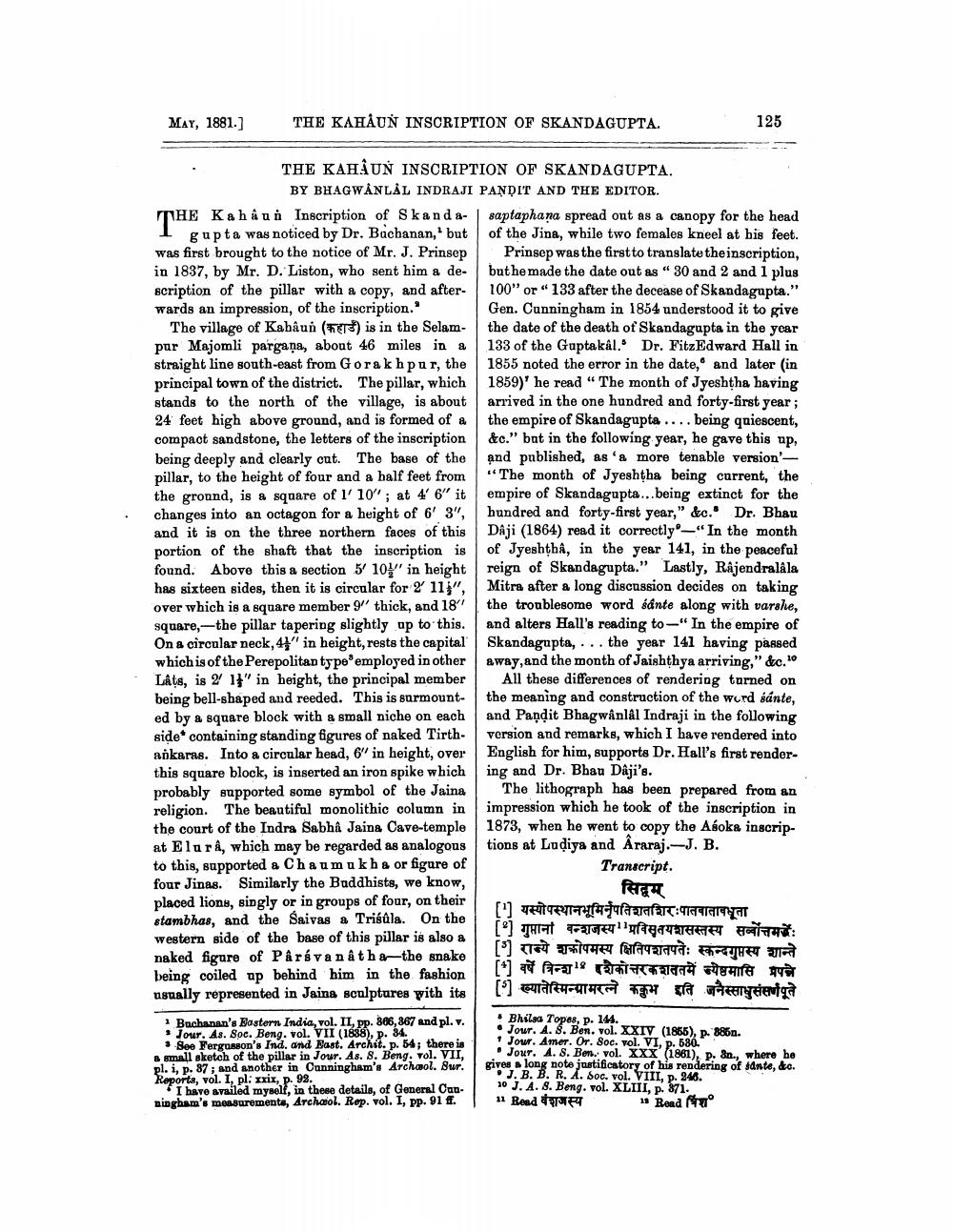________________
MAY, 1881.]
THE KAHAUN INSCRIPTION OF SKANDAGUPTA.
THE KAHAUN INSCRIPTION OF SKANDAGUPTA. BY BHAGWANLAL INDRAJI PANDIT AND THE EDITOR.
The village of Kahâun () is in the Selampur Majomli pargana, about 46 miles in a straight line south-east from Gorakhpur, the principal town of the district. The pillar, which stands to the north of the village, is about 24 feet high above ground, and is formed of a compact sandstone, the letters of the inscription being deeply and clearly cut. The base of the pillar, to the height of four and a half feet from the ground, is a square of 1' 10"; at 4' 6" it changes into an octagon for a height of 6' 3", and it is on the three northern faces of this portion of the shaft that the inscription is found. Above this a section 5' 10" in height has sixteen sides, then it is circular for 2′ 11", over which is a square member 9" thick, and 18" square, the pillar tapering slightly up to this. On a circular neck, 44" in height, rests the capital which is of the Perepolitan type employed in other Lâts, is 2 1" in height, the principal member being bell-shaped and reeded. This is surmounted by a square block with a small niche on each side containing standing figures of naked Tirthankaras. Into a circular head, 6" in height, over this square block, is inserted an iron spike which probably supported some symbol of the Jaina religion. The beautiful monolithic column in the court of the Indra Sabha Jaina Cave-temple at Elurâ, which may be regarded as analogous to this, supported a Chaumukha or figure of four Jinas. Similarly the Buddhists, we know, placed lions, singly or in groups of four, on their stambhas, and the Saivas a Trisûla. On the western side of the base of this pillar is also a naked figure of Pârávanâtha-the snake being coiled up behind him in the fashion usually represented in Jaina sculptures with its
THE THE Kahaun Inscription of Skanda- | saptaphana spread out as a canopy for the head gupta was noticed by Dr. Buchanan,' but of the Jina, while two females kneel at his feet. was first brought to the notice of Mr. J. Prinsep Prinsep was the first to translate the inscription, in 1837, by Mr. D. Liston, who sent him a de- but he made the date out as " 30 and 2 and 1 plus scription of the pillar with a copy, and after- 100" or "133 after the decease of Skandagupta." wards an impression, of the inscription." Gen. Cunningham in 1854 understood it to give the date of the death of Skandagupta in the year 133 of the Guptakâl. Dr. FitzEdward Hall in 1855 noted the error in the date, and later (in 1859)' he read "The month of Jyeshtha having arrived in the one hundred and forty-first year; the empire of Skandagupta.... being quiescent, &c." but in the following year, he gave this up, and published, as 'a more tenable version'"The month of Jyeshtha being current, the empire of Skandagupta...being extinct for the hundred and forty-first year," &c. Dr. Bhau Dâji (1864) read it correctly-"In the month of Jyeshthâ, in the year 141, in the peaceful reign of Skandagupta." Lastly, Rajendralâla Mitra after a long discussion decides on taking the troublesome word sånte along with varshe, and alters Hall's reading to-" In the empire of Skandagupta,... the year 141 having passed away, and the month of Jaishthya arriving," &c. 10
1 Buchanan's Eastern India, vol. II, pp. 366,367 and pl. v. Jour. As. Soc. Beng. vol. VII (1888), p. 34.
3 See Fergusson's Ind. and East. Archit. p. 54; there is a small sketch of the pillar in Jour. As. 8. Beng, vol. VII, pl. i, p. 87; and another in Cunningham's Archaeol. Sur. Reports, vol. I, pl. xxix, p. 92.
I have availed myself, in these details, of General Canningham's measurements, Archeol. Rep. vol. I, pp. 91 ff.
125
All these differences of rendering turned on the meaning and construction of the word sánte, and Pandit Bhagwânlâl Indraji in the following version and remarks, which I have rendered into English for him, supports Dr. Hall's first rendering and Dr. Bhau Dâji's.
The lithograph has been prepared from an impression which he took of the inscription in 1873, when he went to copy the Aśoka inscriptions at Ludiya and Araraj.-J. B.
Transcript. सिम
[1] यस्योपस्थानभूमिर्नृपतितशिरा
[2] गुप्तानां वशजस्य ' ' प्रविसृतयशसस्तस्य सव्र्वोत्तमद्धेः [jalt water fuhrmanà angrer auch [+] वर्षे त्रिन्श 18 दशैको तरकशततमें ज्येष्ठमासि प्रपन्ने [] पारिमन्यामरले कम बने
Bhilsa Topes, p. 144..
Jour. A. 8. Ben. vol. XXIV (1855), p. 886n. 1 Jour. Amer. Or. Soc. vol. VI, p. 580.
Jour. A. S. Ben. vol. XXX (1861), p. 3n., where he gives a long note justificatory of his rendering of sante, &c. J. B. B. R. A. Soc. vol. VIII, p. 246.
10 J. A. 8. Beng. vol. XLIII, p. 371. 11. Rond वंशज स्य
13 Read




